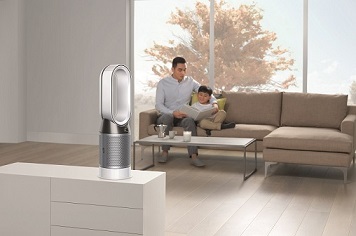First the bad news. Winter’s here, which for most of us means more time indoors. Now the good news: the air we breathe in our homes can be significantly improved with relatively low-cost investments, according to Joseph Allen, director of Harvard’s Healthy Buildings Program.
Allen—along with Harvard Business School colleague John Macomber—is the author of Healthy Buildings: How Indoor Spaces Drive Performance and Productivity (Harvard University Press, 2020). He makes the case that indoor conditions—including air quality—affect both our immediate physical health and long-term cognitive functions like concentration, strategic thinking, troubleshooting, and decision-making.
While Ron Manger, director of sales and marketing for Sharp Electronics Canada, says consumers shouldn’t need a Harvard professor to convince them of the benefit of clean air and good ventilation, he concedes some may still need educating about it.
“People think that because they have a nice, clean-smelling home, it’s fine. But there are so many factors,” says Manger. “There are contaminants, pollen, pet dander, burning fuels, gas fireplaces. Cleaning products that promise shine and a lemony smell can also introduce VOCs that you end up breathing.”
As a consumer solution, Sharp brings to market air purifiers that reduce pollen, dust, pet dander, smoke, germs, bacteria, viruses, odours, mould, and fungus.
There are two types of the recently-introduced Plasmacluster machines, and three models. The Ion technology they all share cleans air by dispersing positively and negatively charged ions, which then neutralizes their charge by attaching to—and reducing—airborne pollutants before returning to the air as invisible water vapor. A HEPA filter eliminates 99.97 per cent of particles that pass through it, including ones as small as 0.3 microns (a human hair is typically between 80 and 100 microns).

The two other Plasmacluster models (appropriate for different sizes of rooms) add a humifying function. That’s important, says Manger, because optimal indoor humidity should be between 40 and 60 per cent. Too low or too high and it can encourage the growth of bacteria, viruses, mould and dust mites, and exacerbate dry-air symptoms, like sinus congestion, swollen and dry nasal passages, bleeding noses, dry throat and eyes, and chapped lips.
Performance of the humidifying model I tested was good. As a light sleeper, I liked that at about 29 decibels, it’s about as quiet as rustling leaves. The control panel is easy to read, and impurity levels are shown on a light panel that changes colour. I liked that the purifying function can run without humidifying the air, which I didn’t need to do in summer. For more flexibility, there’s a three-speed manual adjustment, and an automatic mode that adjusts fan speed for the cleaning required.

a discrete addition to any room. Go to www.sharp.ca for retail availability.
Keep in mind that renovation and building materials can affect air quality.
Dyson’s new Pure Humidify+Cool also cleans and humifies. It matches Sharp’s metrics on particle capture, and adds emphasis on a water tank that uses UV-C technology to kill bacteria. It does so by denaturing its DNA so that it can’t multiply. Water is exposed to multiple rays to kill 99.9 per cent of bacteria in the water in the first pass.
A self-cleaning cycle works on all parts of the machine exposed to water and “Jet Axis Control” features two jets at each side of the air amplifier that work independently to provide direct cooling in oscillation, backwards airflow, and a new breeze mode that mimics natural airflow. In white/silver and black/nickel, they’re about $1,000 at Dyson or Dyson Demo stores in Toronto and Vancouver.

to devise an algorithm to mimic natural airflow.
Prices for the Sharp line run between about $300 and $700. It’s not an insignificant expense, but it’s a justifiable cost if it makes a home healthier, says Manger.
“We have no issue with spending money to replace a cell phones every few years because the camera is better or the screen is bigger. Why not for a humidifier, which will actually provide a healthier sleep and healthier activity level during the day?”





